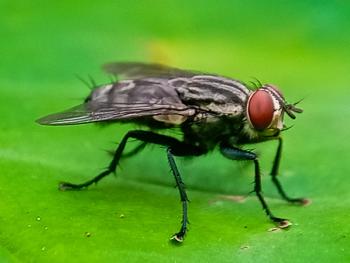
Leptospirosis update (Proceedings)
Various serovars of Leptospira interrogans are the infective agents.
Etiologic Agent
Various serovars of Leptospira interrogans are the infective agents. There are many serovars (200) with 23 serogroups of L. interrogans . There are host adapted species (hardjo in cattle, canicola in dogs) which cause "classic leptospirosis" in the appropriate host. The signs of infection in an non-adapted host can vary from none to severe. In slaughter cattle 34 to 65% had a positive serology for hardjo and 30% of trapped raccoons are positive for grippothyphosa. Other serovars seen in dogs include ictohemorrhagiae, autumnalis, australis, ballum, pomona, and bratislava. Reservoir species include many rodents, skunks, voles, opossum and raccoon. In dogs it is probably the most common cause of acute renal failure. With the appropriate climatic conditions near epidemics can occur. Some serologic surveys have found that in endemic areas up to 30% or more of dogs have been exposed to the non-vaccinal strains.
Pathophysiology and Clinical Findings
Leptospira are transmitted by contact of the organism with mucous membranes, by coitus, abraded skin or bite wounds. After entering the bloodstream the leptospira replicate to produce leptospiremia peaking at 4-12 days post-infection. The signs of leptospiremia can be inapparent or include fever, myalgia and depression. Endothelial damage is apparently common, especially with ictohemorrhagiae infection (signs of DIC). After the initial blood borne phase various organs are colonized. Leptospiruria can occur 72 hours after infection. Because the organism resides in the renal tubule it is protected from clearance by the host immune reaction and can persist for months in the kidneys.
Clinical signs vary depending upon serovar and host. Icterrohemorrhagiae causes a syndrome of liver and renal failure (70% have combination in dogs). A great many dogs are infected and show no apparent clinical signsCanicola is more likely to have only renal disease (15% with liver involvement) as are the other serovars (grippothyphosa, bratislava). Hemorrhagic gastroenteritis is seen in many cases although most likely to be manifested with icterohaemorrhagiae. The renal compromise may also be a factor in the development of this sign. Hypoalbuminemia is common and may be associated with third space loss, intestinal or renal loss. Thrombocytopenia is commonly encountered and is a sign of endothelial damage. This manifestation may be accompanied by prolongations of coagulation parameters and the presence of FDPs. We have seen very low ATIII levels in these dogs also. Renal failure is the most common presentation of leptospirosis at present with varying degrees of severity and progression being noted. This is also the most common long-lasting complication seen in dogs. Liver values can be elevated with leptospirosis, with ALKP exceeding ALT activity significantly. Bilirubin rarely increases in the non-classical cases of lepto in dogs. Rare instances have been found where the damage was limited to the liver, renal involvement was not apparent. Hypokalemia is common and reflects tubular damage. Interestingly gluscosuria occurs commonly with normal blood glucose levels. This is an indication of tubular damage. Proteinuria is relatively uncommon and casts are encountered in the minority of cases. Use of darkfield microscopy can aid in the diagnosis, though it is rare to find the organism in this manner.
Diagnosis
Diagnosis relies upon a microscopic agglutination test (detects antibodies). A one-time strongly elevated titer or a rising titer are suggestive of active infection. Other tests have been devised including an ELISA and PCR (antigen for urine) that have not gained wide application at present. There is cross-reactivity between serovars so by convention the highest individual titer is considered the infecting agent. Culture allows typing and definitive diagnosis but is essentially unavailable. PCR testing of urine is also available and will identify if leptospira are being shed though it does not determine which serovar is involved.
Therapy
Penicillin G is still considered the classic treatment for lepto (40,000 U/kg im or sc every 12 to 24 hrs, dose reduction with azotemia). Because of the problems with dosages in renal failure it is better to use alternative drugs. Ampicillin (22 mg/kg PO, SC, or IV q 6-8 hrs) or amoxicillin (22 mg/kg PO q 8 –12 hrs) can be used. These antibiotics terminate the leptospiremia, but do not clear the renal carrier state. Doxycycline (5 mg/kg BID for 2, better 3 weeks) can be used to clear the leptospiremia as well as the renal carrier state. It does not depend upon the kidney for elimination so dosage adjustment is not needed. Cephalosporins, chloramphenicol, sulfa drugs and possibl the fluoroquinolones may not be very effective, though data is discordant. Streptomycin is commonly reported as a drug of choice but is nephrotoxic and usually not available. Most likely a combination of penicillin and doxycycline is the preferred treatment plan.
General supportive care procedures should be instituted for the renal failure present. Fluid therapy is needed. Urine output should be monitored. Though rare, oligouria can develop and can be addressed with dopamine, lasix or mannitol. It has however been shown that these interventions do not affect outcome, though it is easier to treat a polyuric dog than an oligouric one. In humans there is fairly good evidence to suggest that dopamine should be avoided and possibly lasix as well in ARF. Recent work has suggested that diltiazem may be an option. Researchers gave 0.1 to 0.5 mg/kg slowly i.v. followed by a 1-5 mcg/kg/min CRI. Dogs given this medication had a more rapid drop in creatinine (p=0.054) and more of the dogs returned to normal renal function. Potassium levels can go very low so that appropriate supplementation in the fluids is vital.
Prevention
At present many companies offer a bivalent bacterin vaccine (canicola and ictero.). The use of this vaccine has probably helped to significantly decrease the occurrence of classic lepto. The duration of antibody protection is uncertain and it is possible that although clinical disease may not occur, urine shedding of the organism may. There also are vaccines available for the strains L. grippotyphosa and L. pomona. They appear to be safe and according to the vaccine manufacturers efficacious. Unfortunately, there is no independent data on these vaccines.
References available upon request from the author.
Newsletter
From exam room tips to practice management insights, get trusted veterinary news delivered straight to your inbox—subscribe to dvm360.






